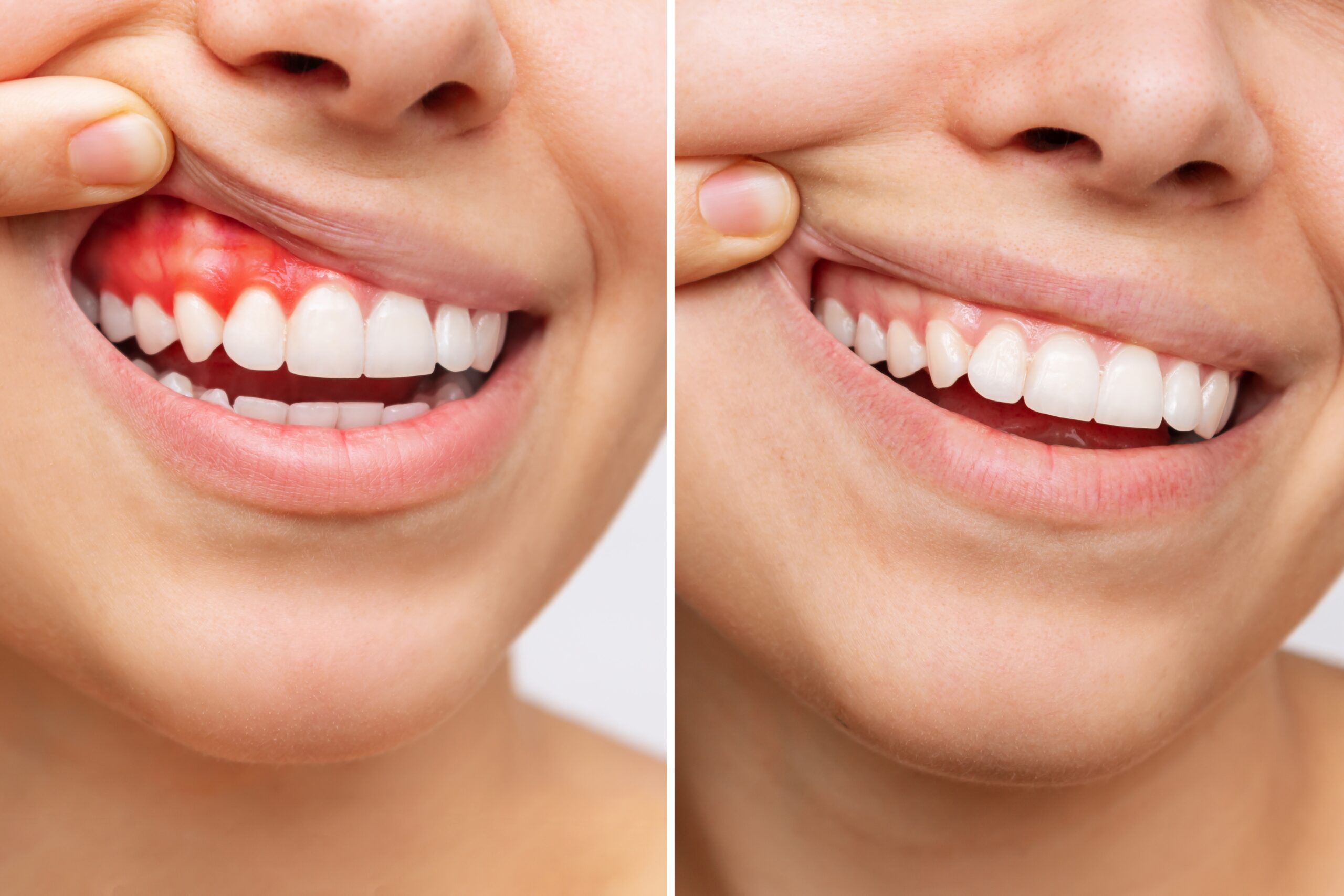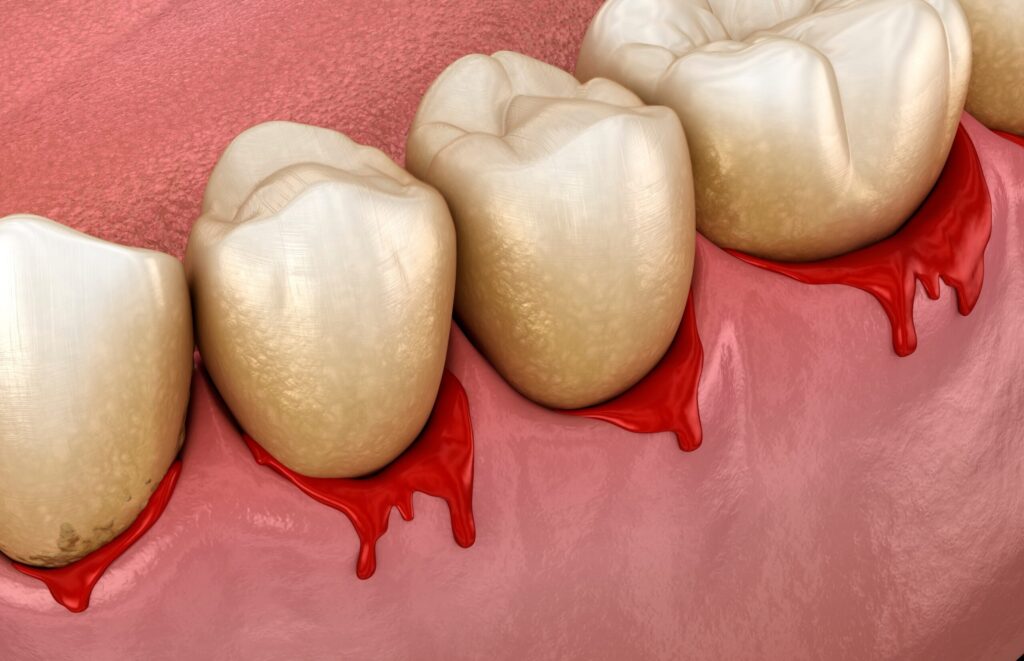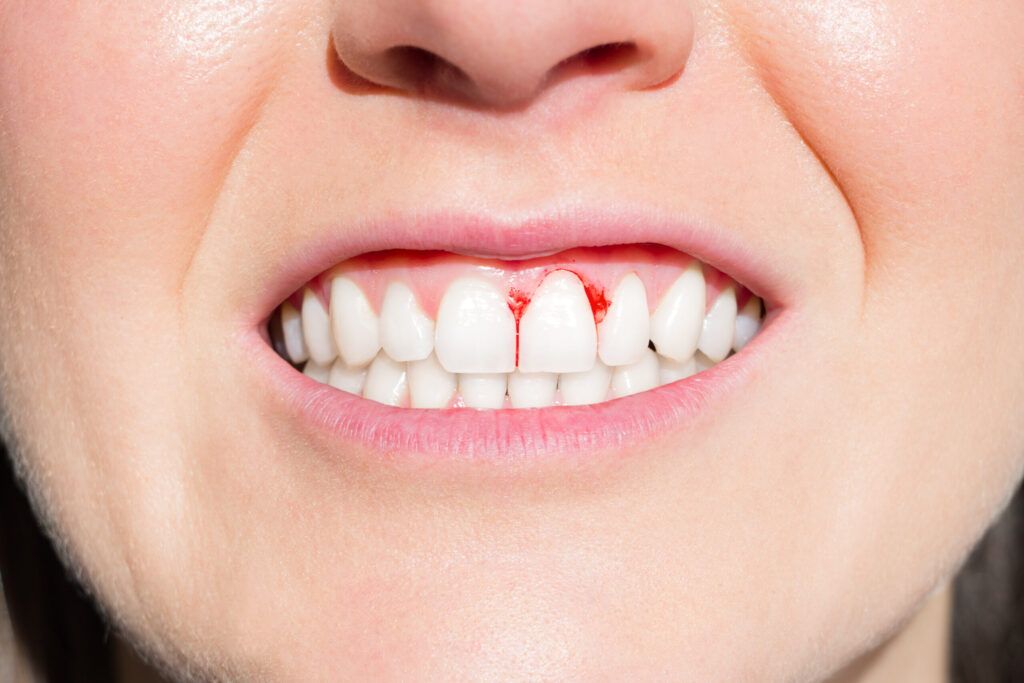Gum Disease Treatment
- Home
- Gum Disease Treatment

Gum Disease
What Is Gum Disease?
Gum disease, referred to as periodontal disease by dentists in Perth, is a common condition that affects the tissues surrounding and supporting the teeth. It is primarily caused by the bacteria found in plaque, a sticky film that forms on the teeth. If not properly removed through regular oral hygiene practices such as brushing and flossing, plaque can harden into a substance called tartar or calculus, increasing the risk of gum disease.
A milder form of gum disease is called gingivitis which is typically reversible by practising good oral hygiene. However, if left untreated, gingivitis can progress to a more severe form of gum disease called periodontitis. Periodontitis can destroy the bone supporting your teeth, leading to tooth loss if left unaddressed.
What Causes Gum Disease?
Several risk factors can contribute to the development and progression of gum disease. These include poor oral hygiene habits, such as inadequate brushing and flossing, which can allow plaque to build up on the teeth and along the gum line. In addition to lifestyle factors like smoking and hormonal changes, genetic predisposition, certain medications, and systemic diseases also play a role. Our experienced dentists at our South Perth dental clinic are well-equipped to help you minimize the risk of gum disease.
Signs and Symptoms of Gum Disease
Recognising the signs and symptoms of gum disease is essential for timely intervention and effective treatment. Gum disease can manifest through various warning signs and symptoms.
Swollen or Bleeding Gums
Swollen or bleeding gums are common signs of early gum disease. When the gums become inflamed and irritated, they may appear swollen, red, or tender. You may also notice bleeding while brushing or flossing.
Bad Breath
Persistent bad breath can be another warning sign of the disease. The presence of harmful bacteria in the mouth can cause an unpleasant odour.
Sensitive Teeth
Experiencing discomfort or pain when consuming hot, cold, sweet, or acidic foods and beverages may indicate gum disease. The receding gums expose the sensitive tooth roots, which can cause heightened sensitivity.
Receding Gums
Gum recession occurs when the gum tissue pulls away from the teeth, exposing the roots. It can be a sign of advanced gum disease. Receding gums may create gaps or periodontal pockets between the teeth and gums, allowing bacteria to accumulate and further damage the supporting structures.
Loose Teeth
The supporting structures, including the bone and periodontal ligament, can be compromised in the advanced stages of gum disease. That can result in loose teeth or changes in tooth alignment. If you notice any shifting or mobility of your teeth, it may indicate severe gum disease. Immediate dental evaluation and treatment are necessary to prevent tooth loss.
Importance of Early Detection and Treatment
It is essential to treat gum disease in its early stages before it can result in tooth loss and other oral health problems. Treating gum disease involves a combination of professional dental care, such as scaling and root planning to remove plaque and tartar and improved oral hygiene practices at home.

Diagnosing Periodontal Disease
Diagnosing gum disease involves a dental examination, medical history review, and using a periodontal probe to measure the pocket depth, indicating the severity of gum disease—the examination checks for gum inflammation, tooth mobility, and plaque buildup. The medical history helps identify factors contributing to the disease.
Nonsurgical Treatments
Non-surgical treatments are often the initial approach for managing gum disease. These procedures aim to remove plaque, tartar, and disease-causing bacteria from the teeth and gums, promoting healing and preventing further damage.
Scaling and Root Planning
Scaling and root planning is a non-surgical treatment focusing on deep cleaning the gum line and tooth surfaces. It is typically recommended when gum pockets are deeper than normal, indicating the presence of gum disease.
During scaling, the dentist or dental hygienist uses special instruments to remove plaque and hardened plaque, known as tartar or calculus, from the teeth and beneath the gum line. This process eliminates the bacteria that contribute to gum inflammation and infection.
Root planning involves smoothing the rough surfaces of the tooth roots. This step helps remove any remaining bacteria and creates a clean surface for the gums to reattach to the teeth, promoting gum health and preventing further progression of the disease.
Antibiotics for Gum Infections
In some cases, antibiotics may be prescribed as part of the treatment for gum infections associated with gum disease. Antibiotics help control the growth of bacteria and reduce inflammation, aiding in healing.
Oral antibiotics may be prescribed for short-term use to address acute gum infections. Topical antibiotics can be applied directly to the infected periodontal pockets. These antibiotics target the bacteria in the specific area, promoting healing and reducing the risk of further infection.
It’s important to note that antibiotics are typically used in conjunction with other treatment options and good oral hygiene practices. Your dentist will determine the most appropriate antibiotic regimen based on the infection’s severity and overall dental health.
Dental Cleaning
Regular dental cleanings are crucial for maintaining dental health, particularly for individuals with gum disease. These procedures are usually performed by a dental hygienist and complement your daily oral hygiene routine.
Surgical Treatments
Surgical treatment options are considered when non-surgical approaches are insufficient or when gum disease requires more extensive treatment. These procedures often involve dental surgery and aim to address specific issues such as tooth root exposure, bone loss, or soft tissue deficiencies.
Flap Surgery
Flap surgery, or pocket reduction surgery, is a surgical treatment for periodontitis. During this procedure, the dentist or periodontist makes incisions in the gums to create a flap, providing access to the tooth roots and underlying bone.
The dentist then thoroughly cleans the tooth root and removes any infected or damaged tissue. In some cases, they may also reshape the bone to eliminate irregularities. The gums are repositioned and sutured once the cleaning and reshaping are complete. It helps reduce pocket depth, making it easier to maintain oral hygiene and prevent further damage.
Bone Grafts
Bone grafts are surgical procedures to treat bone loss caused by severe periodontitis. The goal is to regenerate and restore the lost bone to support the teeth and maintain oral health.
During the procedure, donated bone, synthetic bone, or bone graft materials are placed in the areas of bone loss. It helps stimulate new bone growth.
Gum Tissue Graft
“Soft tissue grafts” is a surgical procedure used to address gum recession and improve the appearance and health of the gum line. During the procedure, the dentist or periodontist takes a small piece of gum tissue from another area of the mouth or uses donated gum tissues.
They then surgically place the graft onto the areas of recession, covering the exposed tooth root. This procedure helps protect the tooth root, reduce sensitivity, and prevent further recession.
Guided Tissue Regeneration (GTR)
Guided tissue regeneration is a surgical technique for regenerating lost bone and periodontal tissues. It is often employed in cases where there is significant bone loss, and the goal is to regenerate the supporting structures around the teeth.
During the treatment, a barrier membrane is placed between the gum tissue and the tooth root. This membrane prevents unwanted tissue from growing into the area, allowing specific cells to repopulate and regenerate bone and periodontal tissues.
Tissue Stimulating Proteins
Tissue-stimulating proteins, also called growth factors, are natural substances that can be used in periodontal treatments to help tissues heal and regenerate. They promote the growth of bone and supporting tissues in the gums. These proteins can be applied to surgical sites or combined with bone graft materials to enhance healing and improve the success of periodontal treatments.

How to Prevent Gum Disease
Following these steps can help prevent gum disease and keep your teeth healthy.
Practice Proper Dental Hygiene: Brush your teeth at least twice daily using fluoride toothpaste. Fluoride helps strengthen the tooth enamel and protect against tooth decay. Use a soft toothbrush and brush all surfaces of your teeth, including along the gumline. Replace your toothbrush every three to four months or sooner if the bristles become frayed.
Floss Daily: Flossing removes plaque and food particles between teeth and the gum line. It helps prevent the buildup of bacteria that can lead to gingivitis. Use a gentle, back-and-forth motion to clean between each tooth. If traditional flossing is challenging, consider using floss picks or interdental brushes.
Visit Your Dentist Regularly: Regular dental check-ups and cleanings are essential for maintaining good oral health and preventing oral diseases. The American Dental Association (ADA) recommends visiting your dentist at least once every six months. Dental professionals can detect early signs of gum disease and provide appropriate treatment or preventive measures.
Maintain a Healthy Lifestyle: A healthy lifestyle can improve oral health. Avoid tobacco use, as it significantly increases the risk of gum disease. Limit consumption of sugary and acidic foods and drinks, as they can contribute to tooth decay and poor oral health. Instead, choose a balanced diet rich in fruits, vegetables, whole grains, and lean proteins.
Manage Medical Conditions: Certain medical conditions, such as diabetes, may increase the risk of gum disease. Managing these conditions effectively and maintaining regular communication with your healthcare provider and dentist is important.
Be Aware of Warning Signs: Pay attention to early signs of gum disease, such as red, swollen, or tender gums, bleeding while brushing or flossing, bad breath, or receding gums.
Acts Dental
Unlock the true potential of your smile at Acts Dental in Perth. Embrace the beauty of natural teeth and the confidence of a healthy mouth. Take charge of your oral health and explore our advanced treatments.
Schedule your appointment now by booking online or calling us at (08) 9474 5083 and discover how we can further enhance your radiant smile.

